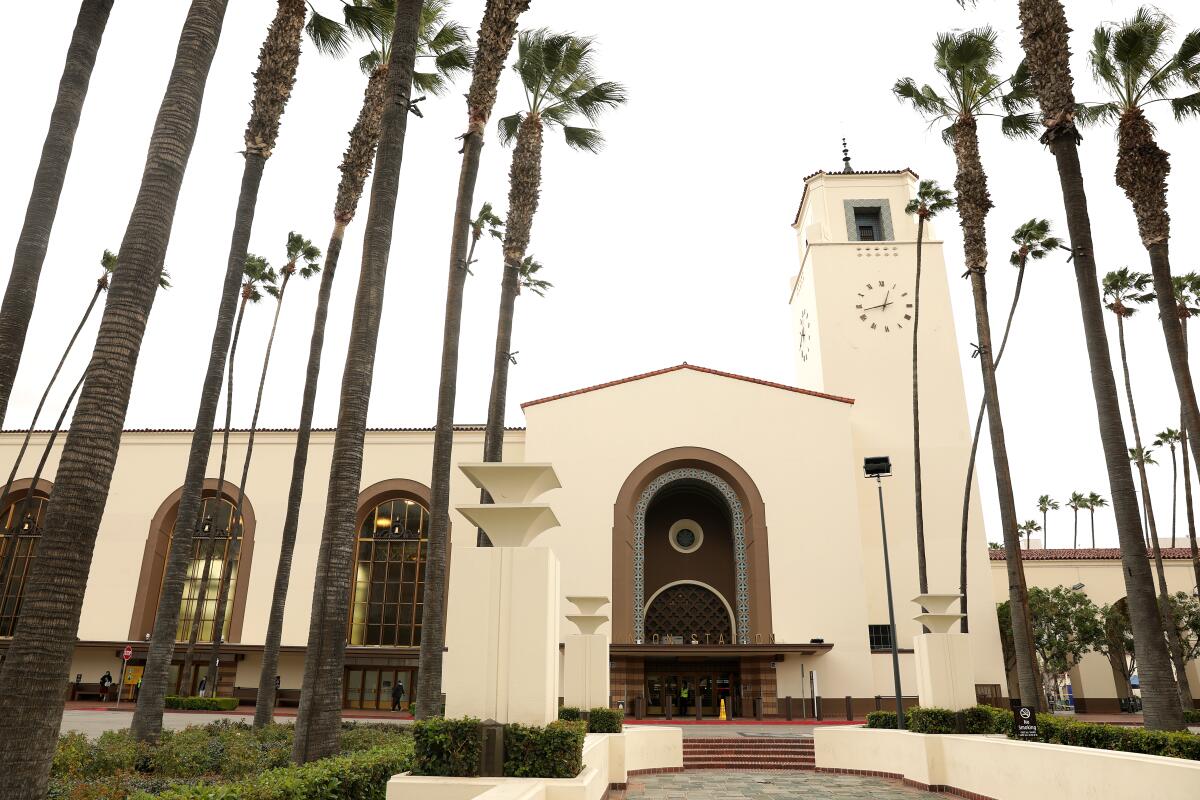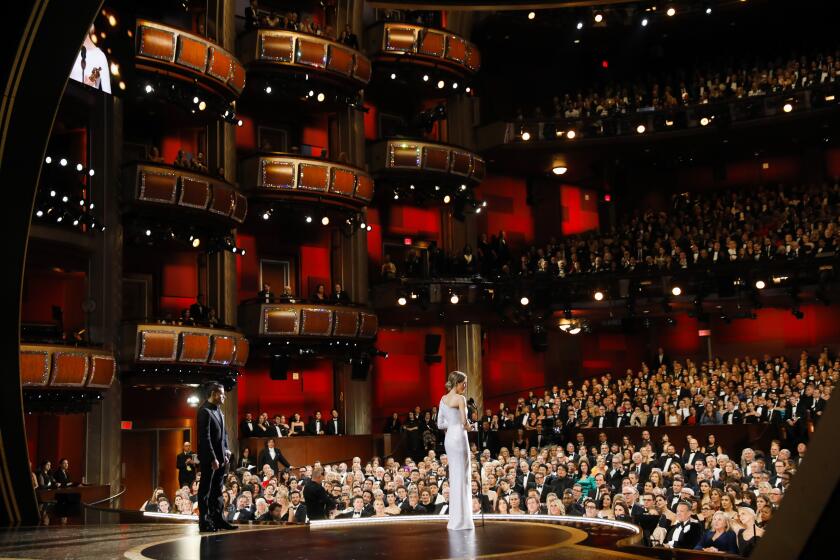Masks at the Oscars? Here’s how the Academy Awards are happening in person

- Share via
Pandemic or no pandemic, the show must go on — and when it comes to Hollywood’s biggest night, Zoom just won’t cut it.
After pushing back the Oscars two full months, from the awards show’s usual perch in late February to this Sunday, the motion picture academy is determined to put on as glitzy and glamorous a telecast as possible — red carpet twirls, teary acceptance speeches and all — while strictly abiding by the latest COVID safety protocols.
Figuring out how to pull that off has been a monumental logistical undertaking for the show’s trio of first-time producers — Steven Soderbergh, Stacey Sher and Jesse Collins — and there have been some major bumps along the way. Here, we will try to answer your burning questions about how it’s all come together.
Are the Oscars really going to be held in person?
Short answer: Yes. Longer answer: It’s complicated.
For the last two decades, the Oscars have been held at the Dolby Theatre in Los Angeles, creating the spectacle viewers have come to love of A-listers packed cheek by jowl into a single room. But in this very abnormal year, given the difficulty of travel and the need for greater distancing, the show will be spread across multiple locations.
Most nominees and presenters will be at Union Station in downtown Los Angeles, with both indoor and outdoor spaces utilized for the evening’s events. Built in 1939 in a blend of Spanish Colonial, Mission Revival and Art Deco styles, the historic landmark presented unique challenges for production designer David Rockwell; for example, nothing could be attached to the ceiling or the floor.
Still reeling from the pandemic, Hollywood hopes the movies are primed for a comeback. The Oscars aim to show fans the path forward.
Further complicating things, the Union Station will continue operating for travelers during the show. And the show itself will be orchestrated a bit like a train station, with attendees rotating in and out of the ceremony according to a carefully timed itinerary that will be given to them upon arrival in order to limit the number of people gathered at one time.
Other elements of the show will be run out of the Dolby Theatre, while, for nominees and presenters unable to travel to the U.S. due to COVID restrictions, a separate hub has been established in the U.K. along with more than 20 satellite hookups for other more far-flung nominees.
While the producers’ insistence on avoiding any participation via Zoom sparked some initial pushback, as Soderbergh told The Times in a recent interview, the goal is to capture as much of the cherished live, in-person Oscars experience as possible.
“It’s the f—ing Oscars. It’s not a webinar,” he said. “So we’re just trying to get people somewhere where we can really make it look great. We want everybody to participate.”
“Nomadland” takes home the best picture, director and lead actress awards at the 2021 Oscars.
Will there be as many attendees as usual?
No. Due to public health restrictions on the number of people allowed to crowd together, the guest list is far smaller than usual. Audience capacity at Union Station will be capped at 170 people. Given that the Dolby Theatre normally holds more than 3,000 people, many Hollywood power players who might normally have been invited will have to watch from home.
As Soderbergh explained at a news conference last weekend, “I’m sure there are some people who normally would be attending going, ‘I don’t understand why I can’t come.’ ... As soon as you open the door beyond nominees, their plus-one and the presenters, you can’t control it. And so that was not even a question for us. Like, this is how it has to be done. [Disney executive] Bob Iger won’t be there. That is just where we are at, and that is how we are being allowed to do it this way.”
True suspense in an acting category. Plenty of historic firsts. That ‘Eurovision’ song. The 2021 Oscars have some intrigue.
Will there be a red carpet?
Sort of. If you’re expecting the sort of endless parade of stars you would normally see, you might be disappointed. But there will be an abbreviated form of traditional red-carpet goings-on during the pre-show at Union Station, albeit with only a handful of reporters who will be required to stand at least seven feet from interviewees.
“It’s not a traditional red carpet,” Sher said at the news conference. “It’s a teeny tiny red carpet. ... Many of those [red-carpet] conversations will happen. They are just going to happen in a more intimate way among the nominees. It’s a very small footprint for safety reasons, obviously.”
How about musical performances?
Instead of being incorporated into the telecast itself as usual, prerecorded performances of the Oscar-nominated songs will be part of this year’s pre-show. “Each song will be done in its entirety,” Collins said at the news conference. “The creative on all of them are unique and beautiful. Everyone performing was excited about that. We’ll introduce these performances in the pre-show, and then in the awards, we’ll find out who won. So if anything, it will add anticipation for the award later in the show.”
Questlove, who was brought on as the show’s musical director, will serve as the in-house DJ at Union Station and will also be part of the show.
A comprehensive guide to which Oscar-nominated films are available on which streaming services, complete with excerpts from Times reviews.
What about other COVID precautions? Will everyone be required to wear a mask at all times?
In a letter sent to this year’s nominees last month, the Oscar producers promised to adhere to the strictest safety standards, writing, “We are treating the event as an active movie set, with specially designed testing cadences to ensure up-to-the-minute results, including an on-site COVID safety team with PCR testing capability.”
Even as COVID continues to upend life around the world, it is certainly a relief to the show’s producers that numbers have been trending in the right direction in California, which currently has the lowest COVID infection rate in the continental U.S. Still, while many, if not most, attending the Oscars are likely at least partially vaccinated at this point, testing is still required and attendees have been asked to stick to a low-risk lifestyle for 10 days before the show, avoiding crowded gyms, restaurants and the like. Temperatures will be checked on site.
Attendees won’t be required to wear masks when they’re on camera but will be asked to put them on during commercial breaks. Asked specifically about mask-wearing during the news conference, Soderbergh avoided answering directly. “Here is our quote on that: Masks are going to play a very important role in the story of this evening,” he said. “And if that is cryptic, it’s meant to be. But that topic is very central to the narrative.”
When it comes to COVID safety more generally, Soderbergh said the film community has had “a lot of practice” in the last year.
“This industry was at the forefront of creating protocols to get people back to work safely,” he said. “I’m in the middle of shooting my second film during COVID. We know how to approach situations like this. It’s incredibly labor intensive. It’s incredibly complex logistically, and it’s expensive.
“There is no universe in which we are going to ever put anybody at risk. And so we are hoping to combine safety with a show that feels like a glimpse of what is going to be possible when most people are vaccinated and, you know, rapid, accurate, cheap testing is the norm. So COVID is going to be there because it’s everywhere, but we want to put it in its place and then sort of move forward.”
Producers of ‘Nomadland,’ ‘Minari,’ ‘Judas and the Black Messiah,’ ‘Mank’ and all the best picture nominees discuss the mixed blessings of the moment.
This all sounds like a logistical nightmare. How is the show’s production team handling all these challenges?
It certainly hasn’t been easy. Speaking to The Times last week, returning Oscars director Glenn Weiss said he threw out virtually his entire playbook from the five previous Oscars he has helmed and that planning for the show has remained fluid as the pandemic has evolved.
“Very honestly, in terms of the how of it all, we had to approach it as a blank slate,” Weiss said. “This isn’t taking out the template of how awards shows work or how the Oscars work — this is creating from scratch. And in a really positive way, by the way, because it really is a little freeing to be able to lead yourself and your team into a new direction.
“It’s never going to be completely dialed in because we’re always walking on eggshells that something might change. We are ahead of everything that we possibly could be but ready for any curveballs that might come.”
More to Read
Only good movies
Get the Indie Focus newsletter, Mark Olsen's weekly guide to the world of cinema.
You may occasionally receive promotional content from the Los Angeles Times.












